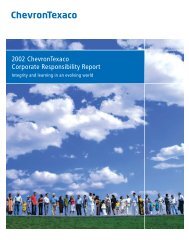Energizing California - Chevron
Energizing California - Chevron
Energizing California - Chevron
Create successful ePaper yourself
Turn your PDF publications into a flip-book with our unique Google optimized e-Paper software.
<strong>Energizing</strong> <strong>California</strong><br />
Milken Institute<br />
It is worth noting, however, that <strong>California</strong>’s GDP has increased at a dramatically faster rate than its population<br />
and motor gasoline consumption rates. The solid line in the graph on the preceding page shows that <strong>California</strong>’s<br />
motor gasoline oil consumption per unit of GDP decreased between 1997 and 2005. This suggests that <strong>California</strong><br />
is growing, with higher productivity levels, and using its energy resources more efficiently.<br />
<strong>California</strong> has led the nation in the drive for greater energy efficiency. The state’s landmark alternative-energy<br />
initiatives aim to develop a clean energy portfolio. Under directions from Assembly Bill 1007 (Pavley, Chapter<br />
371, Statutes of 2005), the Energy Commission and the <strong>California</strong> Air Resources Board (ARB) must collaborate<br />
to execute a statewide strategy for the transportation sector to reduce dependency on traditional fuels and<br />
increase the use of alternative fuels. 16 The state is home to 12 percent of the U.S. population, but contributes<br />
only 6.2 percent of the nation’s greenhouse gas (GHG) emissions, as shown below. 17<br />
Percentage of population and GHG emissions<br />
<strong>California</strong>, 2004<br />
Percentage<br />
14<br />
Percentage of U.S. population Percentage of U.S. emissions<br />
12<br />
10<br />
8<br />
6<br />
4<br />
2<br />
0<br />
United States<br />
Source: <strong>California</strong> Energy Commission.<br />
<strong>California</strong>’s 2003 Energy Action Plan outlined the state’s commitment to developing energy sources that are both<br />
cost-effective and environmentally sensitive. The plan is currently under review and will be updated to reflect<br />
current conditions. The process of achieving these goals will likely involve considerable investments to promote<br />
innovation in energy generation, infrastructure, and policies. 18 The viability of alternative energy sources will<br />
be vital to <strong>California</strong>’s success in meeting future energy demands while ensuring environmental sustainability.<br />
Between 2007 and 2009, <strong>Chevron</strong> plans to spend $2.5 billion in alternative-energy and energy-efficiency<br />
initiatives around the world, with the bulk of this spending allocated in <strong>California</strong>. 19<br />
In 2001, <strong>Chevron</strong> began evaluating the viability of hydrogen as a clean, alternative energy source. Hydrogen<br />
can be produced through solar and wind energy from sources such as biomass and water, and redistributed<br />
according to demand. When used in fuel cells, its byproducts are heat and water. The company is continuing to<br />
engage in research on hydrogen as a viable transportation fuel.<br />
16<br />
Ibid.<br />
17<br />
Susan Brown, “<strong>California</strong> Greenhouse Gas Emission Trends and Selected Policy Options” (<strong>California</strong> Energy Commission, 2004).<br />
18<br />
State of <strong>California</strong>, Energy Action Plan, 2008 update available for download at http://www.energy.ca.gov/energy_action_plan/index.html.<br />
19<br />
<strong>Chevron</strong> Corporation.<br />
26

















